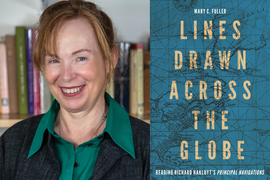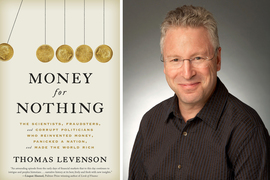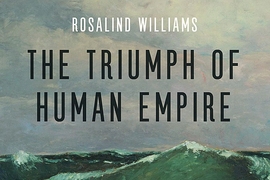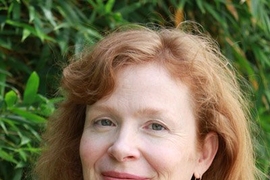In the 1550s, a series of English sailing expeditions went searching for a supposed “Northeast Passage” to China, which they hoped to locate near the top of Europe. No one found it — but English sailors did figure out how to routinely reach Russia. The subsequent founding of the Muscovy Company, the first joint stock trading company, provided a model for many similarly-structured later enterprises.
“England opened and sustained a direct trade with Muscovy,” says MIT professor Mary Fuller. “The English had been voyaging in a scattershot way. But in the process of this concerted attempt in the 1550s to discover a new route to China, English navigators learned new techniques of mathematical navigation. And so they skilled up. And people on the investment and trade side began to create the management and financial infrastructure to support sustained enterprises.”
Today, these are not especially well-known voyages. But to English cleric Richard Hakluyt (1553-1616), one of his country’s leading advocates of overseas exploration, they were highly significant. Spain and Portugal could boast of discovering sea routes to India and the Pacific; the Russian voyages, he claimed, were a sign the English had begun to rival them.
Hakluyt prominently included accounts of those expeditions in a remarkable compendium he published in 1600, “The Principal Navigations, Voyages, Traffiques and Discoveries of the English Nation,” a three-volume, 2,000-page attempt to compile records of all travel English merchants and mariners had taken beyond Europe.
“There’s enormous pride in this,” says Fuller, a professor in MIT’s Literature section who is also chair of the faculty at MIT. “Even though the northern route hadn’t been found, he wants to claim that the effort to find it was itself a world-changing voyage — England was in the game.”
Now in her just-released book, “Lines Drawn across the Globe,” published by McGill-Queen’s University Press, Fuller provides a new reading of Hakluyt’s famed compendium, broadening our view of his aims, and situating his work in a historical moment when England’s ability to explore the world was unproven. Many things that mattered to Hakluyt, including these 1550s voyages, may be forgotten today, but Fuller’s book reconstructs his priorities, worldview, and methods in rich detail.
Broadening the picture
Hakluyt lived through a period of substantial change: England may have been trying to catch up to some of its seafaring rivals around the time he was born, but by 1588 had defeated the Spanish Armada. And Hakluyt participated in England’s expansionist project: He was an advocate for and planner of the short-lived Roanoke colony in America.
As England’s empire reached its furthest extent in the 19th Century, Hakluyt’s work enjoyed a revival; the historian James Froude called Hakluyt’s compendium the “prose epic of the English nation,” and past explorations were used to justify further expansion. “Principal Navigations” documents some of the landmarks of Elizabethan maritime history, including Thomas Harriot’s account of the Roanoke colony; Drake’s circumnavigation of the globe, which lasted from 1577-1580; and material about the 1588 battle with the Spanish Armada. It is no wonder it has become a “founding document of national identity.”
But “Principal Navigations” contains more than these famous stories, and “Lines Drawn across the Globe” contends that visions of Hakluyt’s vast book as the simple expression of an anti-Catholic, Elizabethan triumphalism miss the mark. For one thing, as Fuller writes, “Hakluyt’s compilation had a more expansive scope than its titular focus on the navigations of the English nation would suggest.” In Hakluyt’s volume on voyages to the Americas, the “Principal Navigations” included substantial translated accounts of French, Portugese, and Spanish voyages. Hakluyt was not only recording English exploits; he was collecting knowledge, including knowledge of what other nations had done.
“Lines Drawn across the Globe” also aims to highlight the complexities of the world Hakluyt’s countrymen encountered. At times, English voyagers recognized what they saw as sophisticated and powerful empires, from the Ottoman Empire to the substantial and diverse political and commercial infrastructure of West Africa.
“Ottomans, Muscovites, Spanish, Portugese, and African customs, knowledge, and people were at times derided, excluded, and combatted, at others made the target of imitation, admiration, inclusion, or alliance, admitted as correspondents, enjoys, or brokers,” Fuller writes.
Many accounts in “Principal Navigations” reflect England’s ongoing rivalry with Spain. The privateer John Hawkins, commanding several vessels in 1567, was trapped and attacked by Spanish forces off the coast of Mexico, escaping (along with a cousin, Francis Drake) but leaving much of his crew behind. This voyage was well-documented; Hawkins, doing damage control, wrote an account in part to “argue that he was a victim of perfidious Spain,” Fuller says, and other narratives tell the stories of crew members who were abandoned, lived as captives in Mexico, and managed eventually to return home.
Hakluyt used materials like this to suggest the English were on higher moral ground than the Spanish when it came to their treatment of captives or indeed of indigenous Americans. He is silent on other forms of captivity, however. Hawkins had gone to the Caribbean in an attempt to sell slaves seized in West Africa. This experiment with the Atlantic slave trade would not be repeated for decades, but evidence dispersed across Hakluyt’s compendium suggests that was a practical rather ethical choice.
“There’s a lot of material on enslaved people and on trade in slaves that you can’t find unless you look closely,” Fuller says.
Even as Hakluyt boasted of English naval victories and values, however, he remained intent on urging his countrymen to emulate their Spanish counterparts. Hakluyt ended “Principal Navigations” not with accounts of raids on the Spanish Americas, but of the Spanish naval institutions he hoped could be “established here with us.” Once a peace was signed, he would resume exchanges with Spanish geographers. Overall, Fuller argues, Hakluyt’s work was more complicated, cosmopolitan, and ecumenical than a focus on its greatest hits would suggest.
Scholarly curiosity
“Lines Drawn across the Globe” helps fill a void in Elizabethan maritime history; as Fuller notes in the book, there is no modern critical edition of Hakluyt’s book, the last single-author study dates to 1928, and the most recent index (from 1965) covers only the shorter, first edition of the work that appeared in 1589. Through two decades of research on the subject, Fuller says she has been driven by “curiosity about the details and how they fit together.” She adds: “I want to know what actually happened, and that informs how I understand these texts and the projects of their authors.”
An occasional voyager on seas herself, Fuller has been (with MIT Alumni Travel) to Western Greenland and Hudson Bay, Canada, among other sites. But if she had to pick one place from the “Principal Navigations” to sail to in the future, it would be much further south.
“I would really like to go through the Straits of Magellan,” Fuller says. “Some of those narratives [from there] are so eerie. It’s really like they’re in another world. And it’s not simply because it’s so dangerous. The narratives about the landscape are sublime and fascinating.”
Scholars have praised “Lines Drawn across the Globe.” Joan-Pau Rubiés, a scholar at the Universitat Pompeu Fabra, in Barcelona, calls the book a “magisterial work” and “an indispensable analytical guide to a text whose size and diversity can be daunting.” Daniel Carey of the University of Galway calls it “the most comprehensive guide to reading Hakluyt that is currently available.”
For her part, Fuller observes that her research subject generated productive discussions with colleagues across many disciplines at MIT.
“I think this project was conditioned in important ways by being here,” Fuller says. “I’ve been here since 1989, and the most interesting thing at MIT, beyond teaching, is getting to know colleagues and having conversations across sometimes really distant disciplinary barriers. Whether it was navigation, the cloth trade, or questions about ocean temperature, this topic lent itself to those kinds of connections. It created a broad network, and that was very useful for me.”










